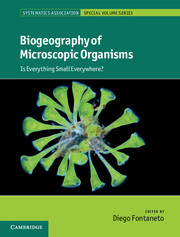Book contents
- Frontmatter
- Contents
- List of contributors
- Preface
- Part I Theoretical framework
- Part II Prokaryotes
- Part III Unicellular eukaryotes
- Part IV Pluricellular eukaryotes
- 9 Coalescent analyses reveal contrasting patterns of intercontinental gene flow in arctic-alpine and boreal-temperate fungi
- 10 Biogeography and phylogeography of lichen fungi and their photobionts
- 11 Biogeography of mosses and allies: does size matter?
- 12 Dispersal limitation or habitat quality – what shapes the distribution ranges of ferns?
- 13 Ubiquity of microscopic animals? Evidence from the morphological approach in species identification
- 14 Molecular approach to micrometazoans. Are they here, there and everywhere?
- Part V Processes
- Index
- Systematics Association Publications
- Systematics Association Special Volumes
- Plate section
- References
12 - Dispersal limitation or habitat quality – what shapes the distribution ranges of ferns?
from Part IV - Pluricellular eukaryotes
Published online by Cambridge University Press: 05 August 2012
- Frontmatter
- Contents
- List of contributors
- Preface
- Part I Theoretical framework
- Part II Prokaryotes
- Part III Unicellular eukaryotes
- Part IV Pluricellular eukaryotes
- 9 Coalescent analyses reveal contrasting patterns of intercontinental gene flow in arctic-alpine and boreal-temperate fungi
- 10 Biogeography and phylogeography of lichen fungi and their photobionts
- 11 Biogeography of mosses and allies: does size matter?
- 12 Dispersal limitation or habitat quality – what shapes the distribution ranges of ferns?
- 13 Ubiquity of microscopic animals? Evidence from the morphological approach in species identification
- 14 Molecular approach to micrometazoans. Are they here, there and everywhere?
- Part V Processes
- Index
- Systematics Association Publications
- Systematics Association Special Volumes
- Plate section
- References
Summary
Introduction
Ferns are the second largest vascular plant group on earth with more than 9000 living species currently placed in four classes: (1) whisk ferns – Psilotopsida, c. 92 species, (2) horsetails – Equisetopsida, c. 15 species, (3) marattioid ferns – Marattiopsida, c. 150 species, and (4) leptosporangiate ferns – Polypodiopsida, c. 9000 species (Smith et al., 2006). Their origin dates back to the Late Devonian or early Carboniferous more than 350 million years ago (Pryer et al., 2004). They reproduce by haploid spores, which grow into a free-living gametophyte, usually a photosynthetic prothallus with microscopic male and female organs. The male sexual organs, the anteridia, release mobile sperms that swim to the female sexual organs, the archegonia (often on the same prothallus), and fertilise an egg that remains attached to the prothallus. The resulting zygotes divide by mitoses and grow into the diploid sporophytes, usually with characteristic rhizome and fronds (Lloyd, 1974). Most of the ferns are perennial hemicryptophytes (less commonly tree ferns, rarely annuals) that produce up to millions of tiny, long-lived, mostly wind-dispersed spores every year (Smith et al., 2006). The notable exceptions are some genera of Polypodiaceae (e.g. Grammitis, Jungermannia), which produce relatively few, chlorophyllous spores per frond that live only days or weeks (Schaefer, 2001a) and some water- or bird-dispersed heterosporous ferns (Marsileaceae, Salviniaceae).
- Type
- Chapter
- Information
- Biogeography of Microscopic OrganismsIs Everything Small Everywhere?, pp. 234 - 243Publisher: Cambridge University PressPrint publication year: 2011
References
- 3
- Cited by



